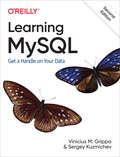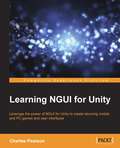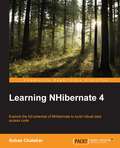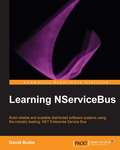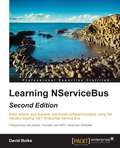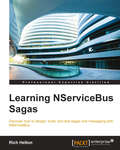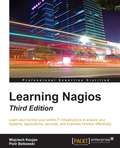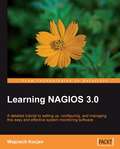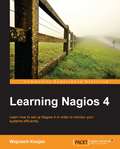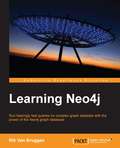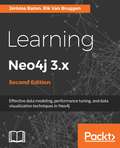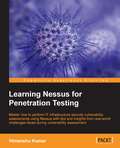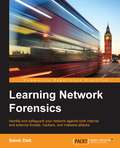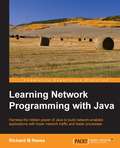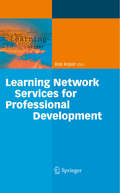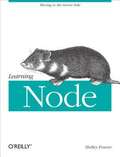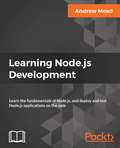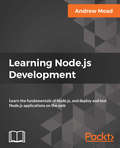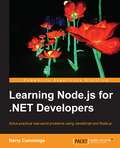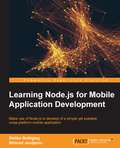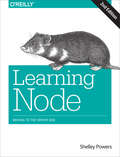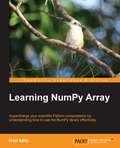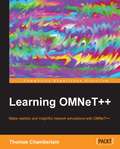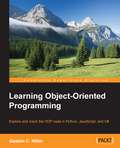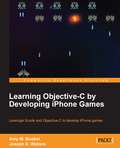- Table View
- List View
Learning MySQL: Get a Handle on Your Data
by Vinicius M. Grippa Sergey KuzmichevGet a comprehensive overview on how to set up and design an effective database with MySQL. This thoroughly updated edition covers MySQL's latest version, including its most important aspects. Whether you're deploying an environment, troubleshooting an issue, or engaging in disaster recovery, this practical guide provides the insights and tools necessary to take full advantage of this powerful RDBMS.Authors Vinicius Grippa and Sergey Kuzmichev from Percona show developers and DBAs methods for minimizing costs and maximizing availability and performance. You'll learn how to perform basic and advanced querying, monitoring and troubleshooting, database management and security, backup and recovery, and tuning for improved efficiency. This edition includes new chapters on high availability, load balancing, and using MySQL in the cloud.Get started with MySQL and learn how to use it in productionDeploy MySQL databases on bare metal, on virtual machines, and in the cloudDesign database infrastructuresCode highly efficient queriesMonitor and troubleshoot MySQL databasesExecute efficient backup and restore operationsOptimize database costs in the cloudUnderstand database concepts, especially those pertaining to MySQL
Learning NGUI for Unity
by Charles PearsonIf you are a Unity 3D developer who wants to create an effective and user-friendly GUI using NGUI for Unity, then this book is for you. Prior knowledge of C# scripting is expected; however, no knowledge of NGUI is required.
Learning NHibernate 4
by Suhas ChatekarThis book targets .NET developers who have never used an ORM before, developers who have used an ORM before but are new to NHibernate, or have used NHibernate sparingly and want to learn more about NHibernate.
Learning NServiceBus
by David BoikeThis is a practical tutorial containing hands-on examples for creating a messaging and SOA based service bus.This book is for .NET developers who are looking for ways to overcome problems related to buggy third party web service integrations, codebases that have grown into a big ball of mud, and batch jobs failure.
Learning NServiceBus - Second Edition
by David BoikeIf you are a .NET developer who wants to eliminate the problems related to defective third-party web service integration or batch job failures, then this is the book for you. It is also perfect for those of you who are new to NServiceBus and service-oriented architecture and would like to learn how you can streamline all of your development efforts.
Learning NServiceBus Sagas
by Rich HeltonIf you are an Enterprise C# developer who wishes to extend your knowledge of NServiceBus and Enterprise Service Bus in C#, this is the book for you. This book is designed to enhance the education of ESBs and their messaging, whether you are a beginner or a seasoned expert in Enterprise C#, Apex, and Visualforce pages.
Learning Nagios - Third Edition
by Wojciech Kocjan Piotr BeltowskiLearn and monitor your entire IT infrastructure to ensure your systems, applications, services, and business function effectively. About This Book * Packed with tips, tricks and illustrations, the book will explain the configuration and monitoring concepts in a simplified manner * Experience the scalability and flexibility of Nagios in a very practical and easy-to-understand approach. * Unleash the power of Nagios Core and Nagios XI 5 to monitor and secure your infrastructure with ease. Who This Book Is For This book is targeted at System Administrators, both, who have no prior knowledge of Nagios as well as readers experienced with it. It not only covers the basics of Nagios but also the advanced features. What You Will Learn * Set up and use the built-in Nagios web interface * Upskill the additional interfaces available for Nagios to monitor your IT infrastructure * Learn how to perform various checks using both, Nagios standard plugins and third-party plugins * Explore the working of notifications and events in Nagios * Familiarize yourself with SNMP and use it for monitoring devices such as routers, switches, modems and printers * Discover how can be Nagios can be customized and tailored to your needs * Get to know more about the entreprise version of Nagios, Nagios XI In Detail Nagios, a powerful and widely used IT monitoring and management software for problem -solving. It detects problems related to your organizations infrastructure and helps in resolving the issue before it impacts the business. Following the success of the previous edition, this book will continue to help you monitor the status of network devices and also notify the system administrators of network problems. Starting with the fundamentals, the book will teach you how to install and configure Nagios for your environment. The book helps you learn how to end downtimes, adding comments and generating reports using the built-in Web interface of Nagios. Moving on, you will be introduced to the third-party web interfaces and applications for checking the status and report specific information. As you progress further in Learning Nagios, you will focus on the standard set of Nagios plugins and also focus on teach you how to efficiently manage large configurations and using templates. Once you are up to speed with this, you will get to know the concept and working of notifications and events in Nagios. The book will then uncover the concept of passive check and shows how to use NRDP (Nagios Remote Data Processor). The focus then shifts to how Nagios checks can be run on remote machines and SNMP (Simple Network Management Protocol) can be used from Nagios. Lastly, the book will demonstrate how to extend Nagios by creating custom check commands, custom ways of notifying users and showing how passive checks and NRDP can be used to integrate your solutions with Nagios. By the end of the book, you will be a competent system administrator who could monitor mid-size businesses or even large scale enterprises. Style and approach This will be a practical learning guide for system administrators which will teach them everything about Nagios along with implementing it for your organization and then ending with securing it.
Learning Nagios 3.0
by Wojciech KocjanThis is a beginner-level book, which will introduce Nagios to System Administrators who are interested in monitoring their systems. The focus is on teaching system administrators to secure their systems in a much improved manner incorporating the newer features of Nagios. It will teach Nagios beginners the basics of installation and configuration of version 3; it will show professionals who have already worked on earlier versions of Nagios the new features of Nagios like inheritance and also the new internal functions like better check scheduling. The target readers for this book are System Administrators interested in using Nagios. This book will introduce Nagios with the new features of Version 3 for System Administrators.
Learning Nagios 4
by Wojciech KocjanThis book will introduce Nagios to readers who are interested in monitoring their systems. All the concepts in the book are explained in a simplified manner, presented in an easy-to-understand language with lots of tips, tricks, and illustrations. This book is great for system administrators interested in using Nagios to monitor their systems. It will also help professionals who have already worked with earlier versions of Nagios to understand the new features of Nagios 4 and provides usable solutions to real-life problems related to Nagios administration. To effectively use this book, system administration knowledge is required. If you want to create your own plug-ins, knowledge of scripting languages like Perl, shell and Python is expected.
Learning Neo4j
by Rik Van BruggenThis book is for developers who want an alternative way to store and process data within their applications. No previous graph database experience is required; however, some basic database knowledge will help you understand the concepts more easily.
Learning Neo4j 3.x - Second Edition
by Rik Van Bruggen Jerome BatonRun blazingly fast queries on complex graph datasets with the power of the Neo4j graph database About This Book • Get acquainted with graph database systems and apply them in real-world use cases • Use Cypher query language, APOC and other Neo4j extensions to derive meaningful analysis from complex data sets. • A practical guide filled with ready to use examples on querying, graph processing and visualizing information to build smarter spatial applications. Who This Book Is For This book is for developers who want an alternative way to store and process data within their applications. No previous graph database experience is required; however, some basic database knowledge will help you understand the concepts more easily. What You Will Learn • Understand the science of graph theory, databases and its advantages over traditional databases. • Install Neo4j, model data and learn the most common practices of traversing data • Learn the Cypher query language and tailor-made procedures to analyze and derive meaningful representations of data • Improve graph techniques with the help of precise procedures in the APOC library • Use Neo4j advanced extensions and plugins for performance optimization. • Understand how Neo4j's new security features and clustering architecture are used for large scale deployments. In Detail Neo4j is a graph database that allows traversing huge amounts of data with ease. This book aims at quickly getting you started with the popular graph database Neo4j. Starting with a brief introduction to graph theory, this book will show you the advantages of using graph databases along with data modeling techniques for graph databases. You'll gain practical hands-on experience with commonly used and lesser known features for updating graph store with Neo4j's Cypher query language. Furthermore, you'll also learn to create awesome procedures using APOC and extend Neo4j's functionality, enabling integration, algorithmic analysis, and other advanced spatial operation capabilities on data. Through the course of the book you will come across implementation examples on the latest updates in Neo4j, such as in-graph indexes, scaling, performance improvements, visualization, data refactoring techniques, security enhancements, and much more. By the end of the book, you'll have gained the skills to design and implement modern spatial applications, from graphing data to unraveling business capabilities with the help of real-world use cases. Style and approach A step-by-step approach of adopting Neo4j, the world's leading graph database. This book includes a lot of background information, helps you grasp the fundamental concepts behind this radical new way of dealing with connected data, and will give you lots of examples of use cases and environments where a graph database would be a great fit
Learning Nessus for Penetration Testing
by Himanshu KumarThis book is a friendly tutorial that uses several examples of real-world scanning and exploitation processes which will help get you on the road to becoming an expert penetration tester. Learning Nessus for Penetration Testing is ideal for security professionals and network administrators who wish to learn how to use Nessus to conduct vulnerability assessments to identify vulnerabilities in IT infrastructure quickly and efficiently.
Learning Network Forensics
by Samir DattIdentify and safeguard your network against both internal and external threats, hackers, and malware attacks About This Book * Lay your hands on physical and virtual evidence to understand the sort of crime committed by capturing and analyzing network traffic * Connect the dots by understanding web proxies, firewalls, and routers to close in on your suspect * A hands-on guide to help you solve your case with malware forensic methods and network behaviors Who This Book Is For If you are a network administrator, system administrator, information security, or forensics professional and wish to learn network forensic to track the intrusions through network-based evidence, then this book is for you. Basic knowledge of Linux and networking concepts is expected. What You Will Learn * Understand Internetworking, sources of network-based evidence and other basic technical fundamentals, including the tools that will be used throughout the book * Acquire evidence using traffic acquisition software and know how to manage and handle the evidence * Perform packet analysis by capturing and collecting data, along with content analysis * Locate wireless devices, as well as capturing and analyzing wireless traffic data packets * Implement protocol analysis and content matching; acquire evidence from NIDS/NIPS * Act upon the data and evidence gathered by being able to connect the dots and draw links between various events * Apply logging and interfaces, along with analyzing web proxies and understanding encrypted web traffic * Use IOCs (Indicators of Compromise) and build real-world forensic solutions, dealing with malware In Detail We live in a highly networked world. Every digital device--phone, tablet, or computer is connected to each other, in one way or another. In this new age of connected networks, there is network crime. Network forensics is the brave new frontier of digital investigation and information security professionals to extend their abilities to catch miscreants on the network. The book starts with an introduction to the world of network forensics and investigations. You will begin by getting an understanding of how to gather both physical and virtual evidence, intercepting and analyzing network data, wireless data packets, investigating intrusions, and so on. You will further explore the technology, tools, and investigating methods using malware forensics, network tunneling, and behaviors. By the end of the book, you will gain a complete understanding of how to successfully close a case. Style and approach An easy-to-follow book filled with real-world case studies and applications. Each topic is explained along with all the practical tools and software needed, allowing the reader to use a completely hands-on approach.
Learning Network Programming with Java
by Richard M ReeseHarness the hidden power of Java to build network-enabled applications with lower network traffic and faster processes About This Book * Learn to deliver superior server-to-server communication through the networking channels * Gain expertise of the networking features of your own applications to support various network architectures such as client/server and peer-to-peer * Explore the issues that impact scalability, affect security, and allow applications to work in a heterogeneous environment Who This Book Is For Learning Network Programming with Java is oriented to developers who wish to use network technologies to enhance the utility of their applications. You should have a working knowledge of Java and an interest in learning the latest in network programming techniques using Java. No prior experience with network development or special software beyond the Java SDK is needed. Upon completion of the book, beginner and experienced developers will be able to use Java to access resources across a network and the Internet. What You Will Learn * Connect to other applications using sockets * Use channels and buffers to enhance communication between applications * Access network services and develop client/server applications * Explore the critical elements of peer-to-peer applications and current technologies available * Use UDP to perform multicasting * Address scalability through the use of core and advanced threading techniques * Incorporate techniques into an application to make it more secure * Configure and address interoperability issues to enable your applications to work in a heterogeneous environment In Detail Network-aware applications are becoming more prevalent and play an ever-increasing role in the world today. Connecting and using an Internet-based service is a frequent requirement for many applications. Java provides numerous classes that have evolved over the years to meet evolving network needs. These range from low-level socket and IP-based approaches to those encapsulated in software services. This book explores how Java supports networks, starting with the basics and then advancing to more complex topics. An overview of each relevant network technology is presented followed by detailed examples of how to use Java to support these technologies. We start with the basics of networking and then explore how Java supports the development of client/server and peer-to-peer applications. The NIO packages are examined as well as multitasking and how network applications can address practical issues such as security. A discussion on networking concepts will put many network issues into perspective and let you focus on the appropriate technology for the problem at hand. The examples used will provide a good starting point to develop similar capabilities for many of your network needs. Style and approach Each network technology's terms and concepts are introduced first. This is followed up with code examples to explain these technologies. Many of the examples are supplemented with alternate Java 8 solutions when appropriate. Knowledge of Java 8 is not necessary but these examples will help you better understand the power of Java 8.
Learning Network Services for Professional Development
by Rob KoperA "Learning Network" is a community of people who help each other to better understand and handle certain events and concepts in work or life. As a result - and sometimes also as an aim - participating in learning networks stimulates personal development, a better understanding of concepts and events, career development, and employability. "Learning Network Services" are Web services that are designed to facilitate the creation of distributed Learning Networks and to support the participants with various functions for knowledge exchange, social interaction, assessment and competence development in an effective way. The book presents state-of-the-art insights into the field of Learning Networks and Web-based services which can facilitate all kinds of processes within these networks.
Learning Node
by Shelley PowersTake your web development skills from browser to server with Node--and learn how to write fast, highly scalable network applications on this JavaScript-based platform. With this hands-on guide, you'll quickly master Node's core fundamentals, gain experience with several built-in and contributed modules, and learn the differences and parallels between client- and server-side programming. Get up to speed on Node's event-driven, asynchronous I/O model for developing data-intensive applications that are frequently accessed but computationally simple. If you're comfortable working with JavaScript, this book provides numerous programming and deployment examples to help you take advantage of server-side development with Node. Explore Node's unique approach to asynchronous development Build sample Node applications with the Express framework and Connect middleware Use NoSQL solutions such as Redis and MongoDB--and explore Node's relational database modules Work with PDF files, serve HTML5 media, and create graphics with Canvas Set up bidirectional communication between browser and server with WebSockets Learn in-depth practices for debugging and testing your applications Deploy Node applications in the cloud or on your own system "Learning Node will make it easy for someone from any programming background to get a grip on Node.js and build amazing projects." --Tom Hughes-Croucher, co-author of Node: Up and Running (O'Reilly)
Learning Node.js Development: Learn The Fundamentals Of Node. Js, And Deploy And Test Node. Js Applications On The Web
by Andrew Mead<P><P>A comprehensive, easy-to-follow guide to creating complete Node apps and understanding how to build, deploy, and test your own apps. <P><P>Key Features <P><P>Entirely project-based and practical <P><P>Explains the "Why" of Node.js features, not just the "how", providing you with a deep understanding and enabling you to easily apply concepts in your own applications <P><P>Covers the full range of technologies around Node.js - NPM, version control with Git, and much more <P><P>Book Description <P><P>Learning Node.js Development is a practical, project-based book that provides you with all you need to get started as a Node.js developer. Node is a ubiquitous technology on the modern web, and an essential part of any web developers' toolkit. If you are looking to create real-world Node applications, or you want to switch careers or launch a side project to generate some extra income, then you're in the right place. This book has been written around a single goal-turning you into a professional Node developer capable of developing, testing, and deploying real-world production applications. <P><P>Learning Node.js Development is built from the ground up around the latest version of Node.js (version 9.x.x). You'll be learning all the cutting-edge features available only in the latest software versions. <P><P>This book cuts through the mass of information available around Node and delivers the essential skills that you need to become a Node developer. It takes you through creating complete apps and understanding how to build, deploy, and test your own Node apps. It maps out everything in a comprehensive, easy-to-follow package designed to get you up and running quickly. <P><P>What you will learn <P><P>Learn the fundamentals of Node <P><P>Build apps that respond to user input <P><P>Master working with servers <P><P>Learn how to test and debug applications <P><P>Deploy and update your apps in the real world <P><P>Create responsive asynchronous web applications <P><P>Who This Book Is For <P><P>This book targets anyone looking to launch their own Node applications, switch careers, or freelance as a Node developer. You should have a basic understanding of JavaScript in order to follow this course.
Learning Node.js Development: Learn the fundamentals of Node.js, and deploy and test Node.js applications on the web
by Andrew MeadA comprehensive, easy-to-follow guide to creating complete Node apps and understanding how to build, deploy, and test your own apps. Key Features Entirely project-based and practical Explains the "Why" of Node.js features, not just the "how", providing you with a deep understanding and enabling you to easily apply concepts in your own applications Covers the full range of technologies around Node.js – NPM, version control with Git, and much more Book Description Learning Node.js Development is a practical, project-based book that provides you with all you need to get started as a Node.js developer. Node is a ubiquitous technology on the modern web, and an essential part of any web developers' toolkit. If you are looking to create real-world Node applications, or you want to switch careers or launch a side project to generate some extra income, then you're in the right place. This book has been written around a single goal—turning you into a professional Node developer capable of developing, testing, and deploying real-world production applications. Learning Node.js Development is built from the ground up around the latest version of Node.js (version 9.x.x). You'll be learning all the cutting-edge features available only in the latest software versions. This book cuts through the mass of information available around Node and delivers the essential skills that you need to become a Node developer. It takes you through creating complete apps and understanding how to build, deploy, and test your own Node apps. It maps out everything in a comprehensive, easy-to-follow package designed to get you up and running quickly. What you will learn Learn the fundamentals of Node Build apps that respond to user input Master working with servers Learn how to test and debug applications Deploy and update your apps in the real world Create responsive asynchronous web applications Who this book is for This book targets anyone looking to launch their own Node applications, switch careers, or freelance as a Node developer. You should have a basic understanding of JavaScript in order to follow this course.
Learning Node.js for .NET Developers
by Harry CummingsSolve practical real-world problems using JavaScript and Node.js About This Book * Learn the concepts of Node.js to gain a high-level understanding of the Node.js execution model * Build an interactive web application with MongoDB and Redis and create your own JavaScript modules that work both on the client side and server side * Familiarize yourself with the new features of Node.js and JavaScript with this exclusive step-by-step guide Who This Book Is For This book is for developers who want to learn JavaScript and Node.js. Previous experience with programming is desired, but no JavaScript or Node.js knowledge is required. The book focuses mostly on web development, such as networking, serving dynamic pages, and real-time client-server communication. What You Will Learn * Understand which problems Node.js best solves * Write idiomatic JavaScript and Node.js code * Build web applications and command-line tools * Minimise complexity and efficiently solve difficult problems * Test and deploy Node.js applications * Work with persistent data * Implement real-time client-server applications * Integrate .NET and Node.js code In Detail Node.js is an open source, cross-platform runtime environment that allows you to use JavaScript to develop server-side web applications. This short guide will help you develop applications using JavaScript and Node.js, leverage your existing programming skills from .NET or Java, and make the most of these other platforms through understanding the Node.js programming model. You will learn how to build web applications and APIs in Node, discover packages in the Node.js ecosystem, test and deploy your Node.js code, and more. Finally, you will discover how to integrate Node.js and .NET code. Style and approach This is a step-by-step and practical guide to Node.js for .Net developers. It covers the fundamentals relating to typical applications. The focus is on providing the practical skills required to develop applications, with a summary of the key concepts covered.
Learning Node.js for Mobile Application Development
by Stefan Buttigieg Christopher SvanefalkThis book is intended for web developers of all levels of expertise who want to deep dive into cross-platform mobile application development without going through the pains of understanding the languages and native frameworks that form an integral part of developing for different mobile platforms. This book is also for you if you are a developer who wants to capitalize on the MobileFirst strategy and so are going to use JavaScript for your complete stack.
Learning Node: Moving to the Server-Side
by Shelley PowersTake your web development skills from browser to server with Node—and learn how to write fast, highly scalable network applications on this JavaScript-based platform. Updated for the latest Node Long Term Support (LTS) and Node Current (6.0) releases, this hands-on edition helps you master Node’s core fundamentals and gain experience with several built-in and contributed modules.Get up to speed on Node’s event-driven, asynchronous I/O model for developing data-intensive applications that are frequently accessed but computationally simple. If you’re comfortable working with JavaScript, this book provides many programming and deployment examples to help you take advantage of server-side development with Node.Explore the frameworks and functionality for full-stack Node developmentDive into Node’s module system and package management supportTest your application or module code on the fly with Node’s REPL consoleUse core Node modules to build web applications and an HTTP serverLearn Node’s support for networks, security, and socketsAccess operating system functionality with child processesLearn tools and techniques for Node development and productionUse Node in microcontrollers, microcomputers, and the Internet of Things
Learning NumPy Array
by Ivan IdrisA step-by-step guide, packed with examples of practical numerical analysis that will give you a comprehensive, but concise overview of NumPy. This book is for programmers, scientists, or engineers, who have basic Python knowledge and would like to be able to do numerical computations with Python.
Learning OMNeT++
by Thomas ChamberlainThe book uses a concise and practical approach to take you through all the steps necessary to create, run, and analyze your own Network Simulations.This book is ideal for anyone wishing to quickly get to grips with Network Simulation whether you're an expert in networks or just a beginner. It is perfect for all network engineers and administrators who wish to emulate networks using OMNet++ as a preparation for building the actual network.
Learning Object-Oriented Programming
by Gastón C. HillarIf you're a Python, JavaScript, or C# developer and want to learn the basics of object-oriented programming with real-world examples, then this book is for you.
Learning Objective-C by Developing iPhone Games
by Joseph D. Walters Amy M. BookerWritten as a practical and engaging tutorial, this book guides you through the development of your own exciting, fully featured, games. If you are a beginner and an enthusiast who dreams about creating games and is in need of some additional inspiration and knowledge, then this book is for you. No programming experience is expected.
